Assessment and Management of Palliative Care: A Case Study of Metastatic Breast Cancer
VerifiedAdded on 2023/06/08
|8
|2103
|119
AI Summary
This paper highlights the assessment and management of palliative care presented to the patient with metastatic breast cancer. It discusses pain management, nausea and vomiting, constipation, urinary incontinence, and mental distress. The paper also emphasizes the importance of emotional support for the patient's family.
Contribute Materials
Your contribution can guide someone’s learning journey. Share your
documents today.
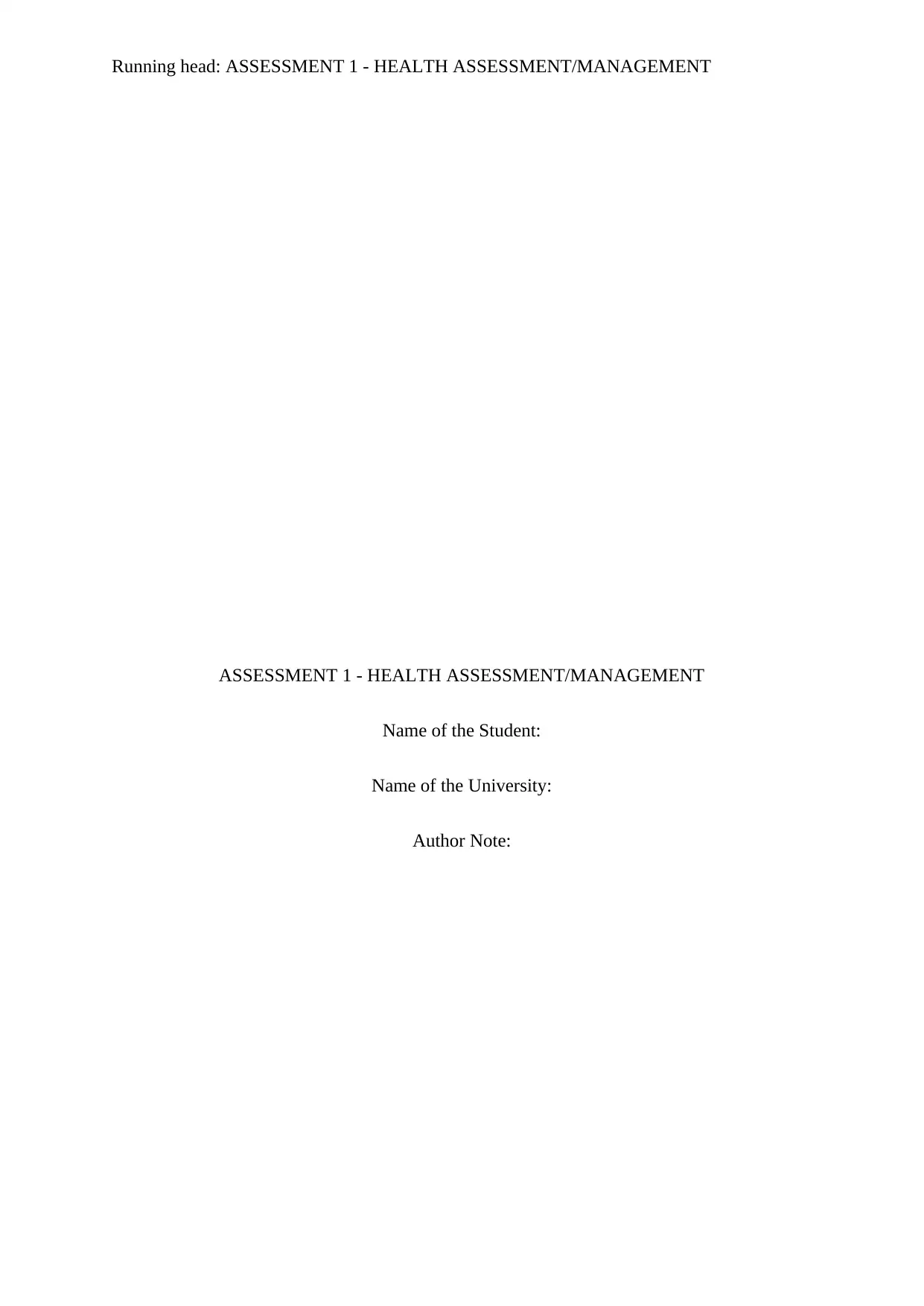
Running head: ASSESSMENT 1 - HEALTH ASSESSMENT/MANAGEMENT
ASSESSMENT 1 - HEALTH ASSESSMENT/MANAGEMENT
Name of the Student:
Name of the University:
Author Note:
ASSESSMENT 1 - HEALTH ASSESSMENT/MANAGEMENT
Name of the Student:
Name of the University:
Author Note:
Secure Best Marks with AI Grader
Need help grading? Try our AI Grader for instant feedback on your assignments.

1
ASSESSMENT 1 - HEALTH ASSESSMENT/MANAGEMENT
This paper thus aims to highlight the assessment and management of palliative care
presented to the patient. The case study is about Sophie who has been diagnosed with
metastatic breast cancer. The patient stated that few years ago she was diagnosed with this
disease after which she had undergone surgery in order to remove the lumps. Followed by
surgery, there were episodes of radiotherapy followed by mastectomy in the left breast and
chemotherapy. However one year later, Sophie again developed a lump. Recently the cancer
has spread even further in the body of the patient. When a bone scan was conducted two
months earlier, the reports showed that the cancer has spread to her spine as well.
As seen from then given situation, Sophie is suffering now from bone metastasis,
which is one of the common site of breast cancer metastasis (Greer et al., 2013). Her
backbone is worsened having a risk of fracture. This condition might call for a pain
assessment examination (Erdek, King & Ellsworth, 2013). The medications that Sophie was
taking was to manage this pain. It has been found that Sophie could be administered with
bisphosphonates recommended by palliative consultant which can reduce pain intensity and
treat malignancy-associated hypercalcemia (Greco et al., 2014). This could also prevent or
delay onset of skeletal-related disease or treatment side effects when used with endocrine
therapy (Greco et al., 2014).
In such a condition, being a palliative nurse, assessment of the patient is required in
order to identify treatment for symptom management effectively and improve the quality of
life of the patient (Irwin et al., 2013). This prevalent situation of the patient called for a need
assessment tool to be used in the palliative care setting. By considering the needs of the
patient, if it is seen that the needs can be managed, then the care should be continued along
with reassessment (Parikh et al., 2013).This is followed by assessment of the needs of the
ASSESSMENT 1 - HEALTH ASSESSMENT/MANAGEMENT
This paper thus aims to highlight the assessment and management of palliative care
presented to the patient. The case study is about Sophie who has been diagnosed with
metastatic breast cancer. The patient stated that few years ago she was diagnosed with this
disease after which she had undergone surgery in order to remove the lumps. Followed by
surgery, there were episodes of radiotherapy followed by mastectomy in the left breast and
chemotherapy. However one year later, Sophie again developed a lump. Recently the cancer
has spread even further in the body of the patient. When a bone scan was conducted two
months earlier, the reports showed that the cancer has spread to her spine as well.
As seen from then given situation, Sophie is suffering now from bone metastasis,
which is one of the common site of breast cancer metastasis (Greer et al., 2013). Her
backbone is worsened having a risk of fracture. This condition might call for a pain
assessment examination (Erdek, King & Ellsworth, 2013). The medications that Sophie was
taking was to manage this pain. It has been found that Sophie could be administered with
bisphosphonates recommended by palliative consultant which can reduce pain intensity and
treat malignancy-associated hypercalcemia (Greco et al., 2014). This could also prevent or
delay onset of skeletal-related disease or treatment side effects when used with endocrine
therapy (Greco et al., 2014).
In such a condition, being a palliative nurse, assessment of the patient is required in
order to identify treatment for symptom management effectively and improve the quality of
life of the patient (Irwin et al., 2013). This prevalent situation of the patient called for a need
assessment tool to be used in the palliative care setting. By considering the needs of the
patient, if it is seen that the needs can be managed, then the care should be continued along
with reassessment (Parikh et al., 2013).This is followed by assessment of the needs of the
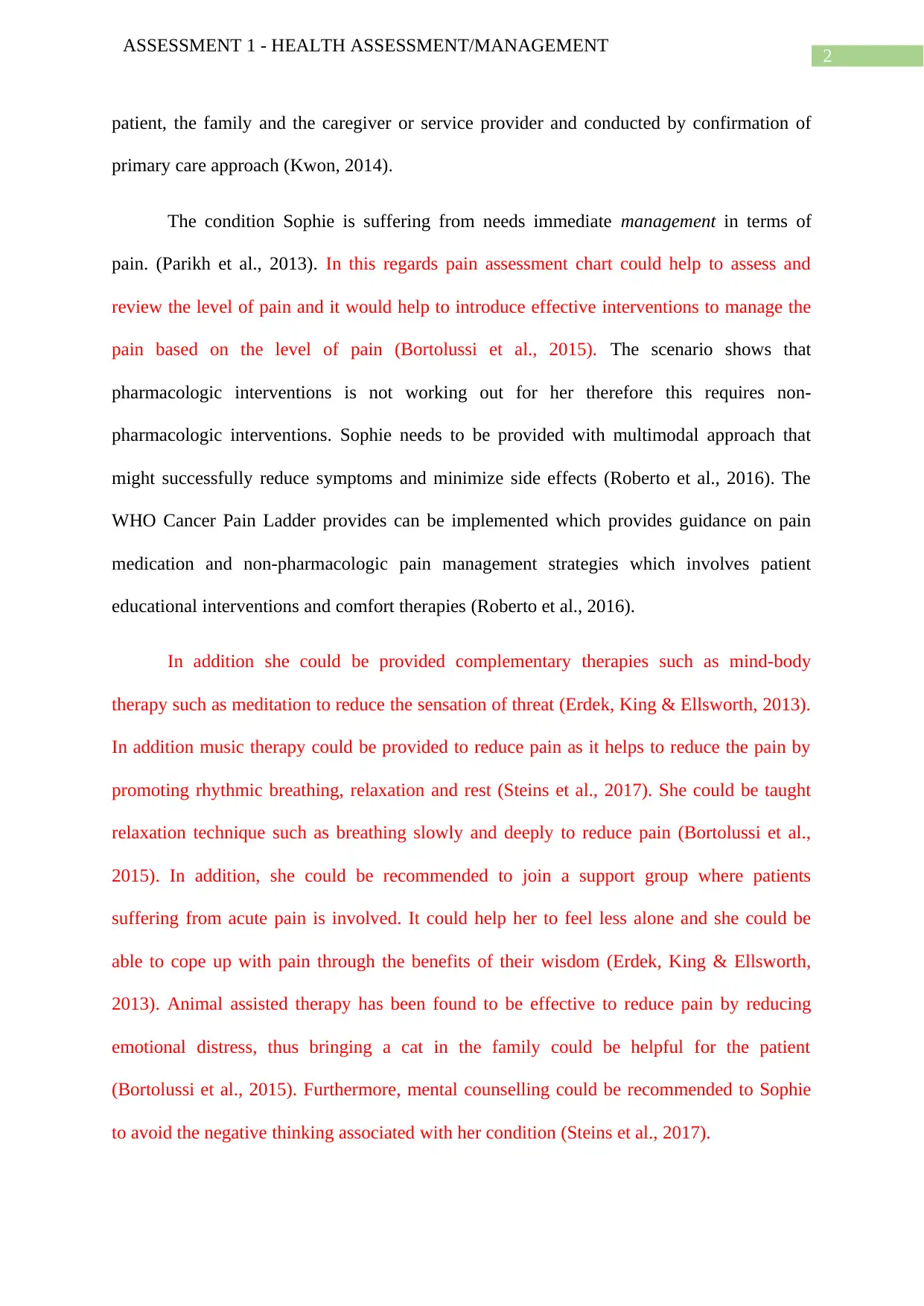
2
ASSESSMENT 1 - HEALTH ASSESSMENT/MANAGEMENT
patient, the family and the caregiver or service provider and conducted by confirmation of
primary care approach (Kwon, 2014).
The condition Sophie is suffering from needs immediate management in terms of
pain. (Parikh et al., 2013). In this regards pain assessment chart could help to assess and
review the level of pain and it would help to introduce effective interventions to manage the
pain based on the level of pain (Bortolussi et al., 2015). The scenario shows that
pharmacologic interventions is not working out for her therefore this requires non-
pharmacologic interventions. Sophie needs to be provided with multimodal approach that
might successfully reduce symptoms and minimize side effects (Roberto et al., 2016). The
WHO Cancer Pain Ladder provides can be implemented which provides guidance on pain
medication and non-pharmacologic pain management strategies which involves patient
educational interventions and comfort therapies (Roberto et al., 2016).
In addition she could be provided complementary therapies such as mind-body
therapy such as meditation to reduce the sensation of threat (Erdek, King & Ellsworth, 2013).
In addition music therapy could be provided to reduce pain as it helps to reduce the pain by
promoting rhythmic breathing, relaxation and rest (Steins et al., 2017). She could be taught
relaxation technique such as breathing slowly and deeply to reduce pain (Bortolussi et al.,
2015). In addition, she could be recommended to join a support group where patients
suffering from acute pain is involved. It could help her to feel less alone and she could be
able to cope up with pain through the benefits of their wisdom (Erdek, King & Ellsworth,
2013). Animal assisted therapy has been found to be effective to reduce pain by reducing
emotional distress, thus bringing a cat in the family could be helpful for the patient
(Bortolussi et al., 2015). Furthermore, mental counselling could be recommended to Sophie
to avoid the negative thinking associated with her condition (Steins et al., 2017).
ASSESSMENT 1 - HEALTH ASSESSMENT/MANAGEMENT
patient, the family and the caregiver or service provider and conducted by confirmation of
primary care approach (Kwon, 2014).
The condition Sophie is suffering from needs immediate management in terms of
pain. (Parikh et al., 2013). In this regards pain assessment chart could help to assess and
review the level of pain and it would help to introduce effective interventions to manage the
pain based on the level of pain (Bortolussi et al., 2015). The scenario shows that
pharmacologic interventions is not working out for her therefore this requires non-
pharmacologic interventions. Sophie needs to be provided with multimodal approach that
might successfully reduce symptoms and minimize side effects (Roberto et al., 2016). The
WHO Cancer Pain Ladder provides can be implemented which provides guidance on pain
medication and non-pharmacologic pain management strategies which involves patient
educational interventions and comfort therapies (Roberto et al., 2016).
In addition she could be provided complementary therapies such as mind-body
therapy such as meditation to reduce the sensation of threat (Erdek, King & Ellsworth, 2013).
In addition music therapy could be provided to reduce pain as it helps to reduce the pain by
promoting rhythmic breathing, relaxation and rest (Steins et al., 2017). She could be taught
relaxation technique such as breathing slowly and deeply to reduce pain (Bortolussi et al.,
2015). In addition, she could be recommended to join a support group where patients
suffering from acute pain is involved. It could help her to feel less alone and she could be
able to cope up with pain through the benefits of their wisdom (Erdek, King & Ellsworth,
2013). Animal assisted therapy has been found to be effective to reduce pain by reducing
emotional distress, thus bringing a cat in the family could be helpful for the patient
(Bortolussi et al., 2015). Furthermore, mental counselling could be recommended to Sophie
to avoid the negative thinking associated with her condition (Steins et al., 2017).
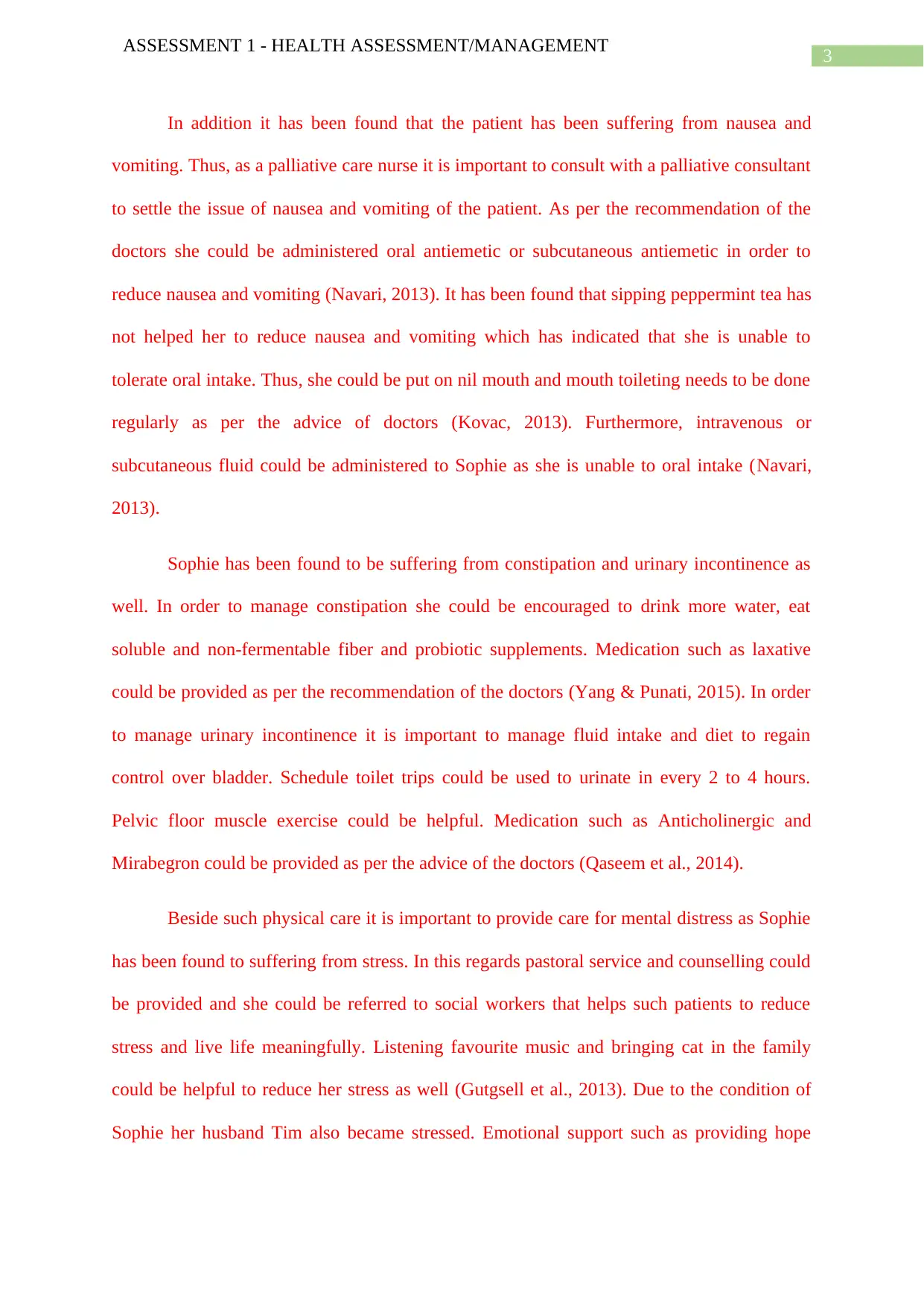
3
ASSESSMENT 1 - HEALTH ASSESSMENT/MANAGEMENT
In addition it has been found that the patient has been suffering from nausea and
vomiting. Thus, as a palliative care nurse it is important to consult with a palliative consultant
to settle the issue of nausea and vomiting of the patient. As per the recommendation of the
doctors she could be administered oral antiemetic or subcutaneous antiemetic in order to
reduce nausea and vomiting (Navari, 2013). It has been found that sipping peppermint tea has
not helped her to reduce nausea and vomiting which has indicated that she is unable to
tolerate oral intake. Thus, she could be put on nil mouth and mouth toileting needs to be done
regularly as per the advice of doctors (Kovac, 2013). Furthermore, intravenous or
subcutaneous fluid could be administered to Sophie as she is unable to oral intake (Navari,
2013).
Sophie has been found to be suffering from constipation and urinary incontinence as
well. In order to manage constipation she could be encouraged to drink more water, eat
soluble and non-fermentable fiber and probiotic supplements. Medication such as laxative
could be provided as per the recommendation of the doctors (Yang & Punati, 2015). In order
to manage urinary incontinence it is important to manage fluid intake and diet to regain
control over bladder. Schedule toilet trips could be used to urinate in every 2 to 4 hours.
Pelvic floor muscle exercise could be helpful. Medication such as Anticholinergic and
Mirabegron could be provided as per the advice of the doctors (Qaseem et al., 2014).
Beside such physical care it is important to provide care for mental distress as Sophie
has been found to suffering from stress. In this regards pastoral service and counselling could
be provided and she could be referred to social workers that helps such patients to reduce
stress and live life meaningfully. Listening favourite music and bringing cat in the family
could be helpful to reduce her stress as well (Gutgsell et al., 2013). Due to the condition of
Sophie her husband Tim also became stressed. Emotional support such as providing hope
ASSESSMENT 1 - HEALTH ASSESSMENT/MANAGEMENT
In addition it has been found that the patient has been suffering from nausea and
vomiting. Thus, as a palliative care nurse it is important to consult with a palliative consultant
to settle the issue of nausea and vomiting of the patient. As per the recommendation of the
doctors she could be administered oral antiemetic or subcutaneous antiemetic in order to
reduce nausea and vomiting (Navari, 2013). It has been found that sipping peppermint tea has
not helped her to reduce nausea and vomiting which has indicated that she is unable to
tolerate oral intake. Thus, she could be put on nil mouth and mouth toileting needs to be done
regularly as per the advice of doctors (Kovac, 2013). Furthermore, intravenous or
subcutaneous fluid could be administered to Sophie as she is unable to oral intake (Navari,
2013).
Sophie has been found to be suffering from constipation and urinary incontinence as
well. In order to manage constipation she could be encouraged to drink more water, eat
soluble and non-fermentable fiber and probiotic supplements. Medication such as laxative
could be provided as per the recommendation of the doctors (Yang & Punati, 2015). In order
to manage urinary incontinence it is important to manage fluid intake and diet to regain
control over bladder. Schedule toilet trips could be used to urinate in every 2 to 4 hours.
Pelvic floor muscle exercise could be helpful. Medication such as Anticholinergic and
Mirabegron could be provided as per the advice of the doctors (Qaseem et al., 2014).
Beside such physical care it is important to provide care for mental distress as Sophie
has been found to suffering from stress. In this regards pastoral service and counselling could
be provided and she could be referred to social workers that helps such patients to reduce
stress and live life meaningfully. Listening favourite music and bringing cat in the family
could be helpful to reduce her stress as well (Gutgsell et al., 2013). Due to the condition of
Sophie her husband Tim also became stressed. Emotional support such as providing hope
Secure Best Marks with AI Grader
Need help grading? Try our AI Grader for instant feedback on your assignments.

4
ASSESSMENT 1 - HEALTH ASSESSMENT/MANAGEMENT
regarding the recovery of Sophie could help Tim and kids to cope up with the situation
(Sanchez-Reilly et al., 2013).
From the above discussion it can be concluded that, effective assessment is helpful to
identify the central need of the patient to introduce adequate treatment. In case of Sophie she
has been assessed properly and identified major health issue such as bone metastasis. Pain
management has been prioritize in the treatment. In addition, constipation, urinary
incontinence, stress, nausea and vomiting are also identified in assessment, thus adequate
medical support has beeb provided to her. It has been found that beside the care of the patient
it is the duty of the palliative carer to provide emotional support to the family of the patient. It
is expected that such palliative support would help a patient like Sophie to improve health
condition effectively
ASSESSMENT 1 - HEALTH ASSESSMENT/MANAGEMENT
regarding the recovery of Sophie could help Tim and kids to cope up with the situation
(Sanchez-Reilly et al., 2013).
From the above discussion it can be concluded that, effective assessment is helpful to
identify the central need of the patient to introduce adequate treatment. In case of Sophie she
has been assessed properly and identified major health issue such as bone metastasis. Pain
management has been prioritize in the treatment. In addition, constipation, urinary
incontinence, stress, nausea and vomiting are also identified in assessment, thus adequate
medical support has beeb provided to her. It has been found that beside the care of the patient
it is the duty of the palliative carer to provide emotional support to the family of the patient. It
is expected that such palliative support would help a patient like Sophie to improve health
condition effectively
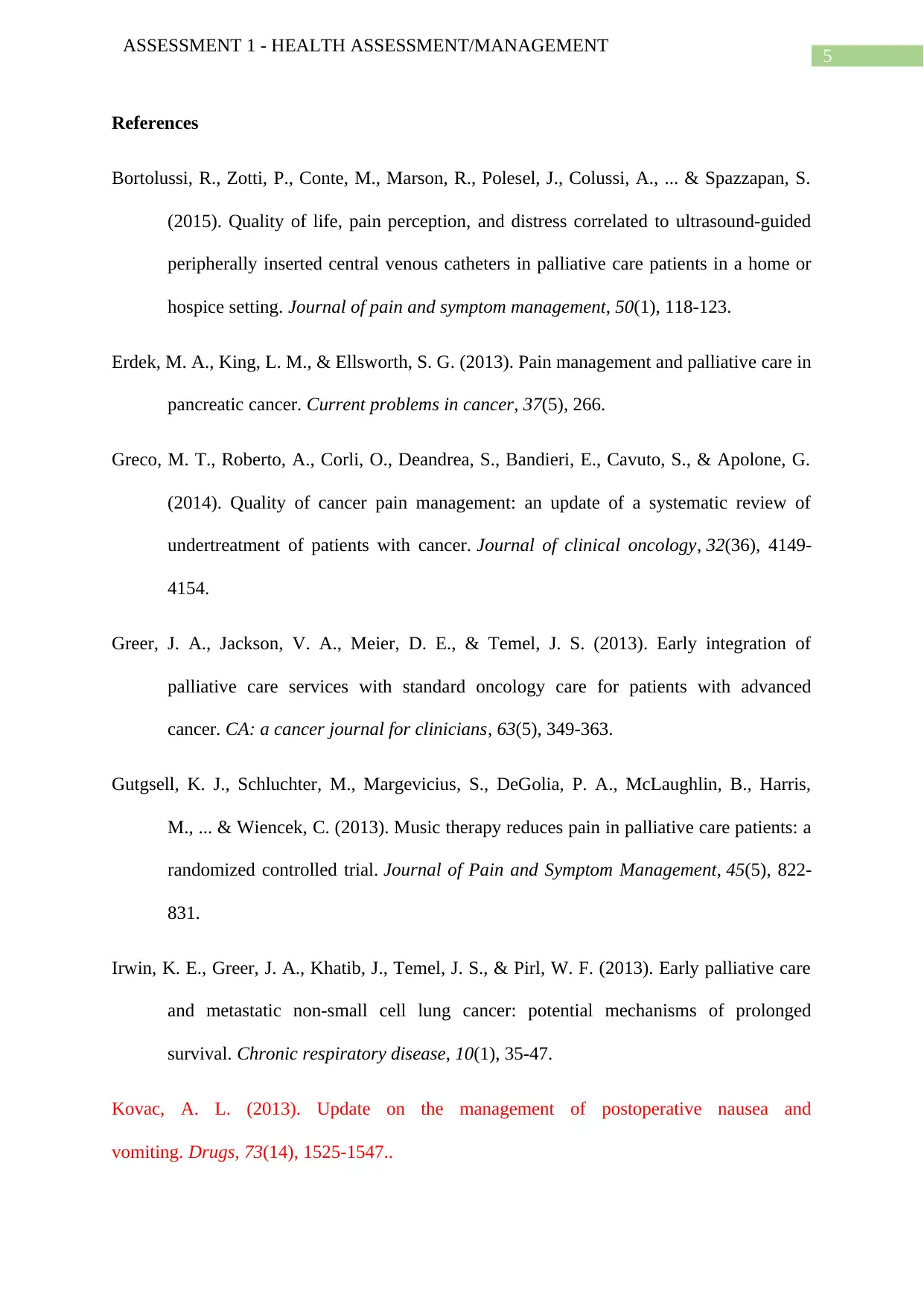
5
ASSESSMENT 1 - HEALTH ASSESSMENT/MANAGEMENT
References
Bortolussi, R., Zotti, P., Conte, M., Marson, R., Polesel, J., Colussi, A., ... & Spazzapan, S.
(2015). Quality of life, pain perception, and distress correlated to ultrasound-guided
peripherally inserted central venous catheters in palliative care patients in a home or
hospice setting. Journal of pain and symptom management, 50(1), 118-123.
Erdek, M. A., King, L. M., & Ellsworth, S. G. (2013). Pain management and palliative care in
pancreatic cancer. Current problems in cancer, 37(5), 266.
Greco, M. T., Roberto, A., Corli, O., Deandrea, S., Bandieri, E., Cavuto, S., & Apolone, G.
(2014). Quality of cancer pain management: an update of a systematic review of
undertreatment of patients with cancer. Journal of clinical oncology, 32(36), 4149-
4154.
Greer, J. A., Jackson, V. A., Meier, D. E., & Temel, J. S. (2013). Early integration of
palliative care services with standard oncology care for patients with advanced
cancer. CA: a cancer journal for clinicians, 63(5), 349-363.
Gutgsell, K. J., Schluchter, M., Margevicius, S., DeGolia, P. A., McLaughlin, B., Harris,
M., ... & Wiencek, C. (2013). Music therapy reduces pain in palliative care patients: a
randomized controlled trial. Journal of Pain and Symptom Management, 45(5), 822-
831.
Irwin, K. E., Greer, J. A., Khatib, J., Temel, J. S., & Pirl, W. F. (2013). Early palliative care
and metastatic non-small cell lung cancer: potential mechanisms of prolonged
survival. Chronic respiratory disease, 10(1), 35-47.
Kovac, A. L. (2013). Update on the management of postoperative nausea and
vomiting. Drugs, 73(14), 1525-1547..
ASSESSMENT 1 - HEALTH ASSESSMENT/MANAGEMENT
References
Bortolussi, R., Zotti, P., Conte, M., Marson, R., Polesel, J., Colussi, A., ... & Spazzapan, S.
(2015). Quality of life, pain perception, and distress correlated to ultrasound-guided
peripherally inserted central venous catheters in palliative care patients in a home or
hospice setting. Journal of pain and symptom management, 50(1), 118-123.
Erdek, M. A., King, L. M., & Ellsworth, S. G. (2013). Pain management and palliative care in
pancreatic cancer. Current problems in cancer, 37(5), 266.
Greco, M. T., Roberto, A., Corli, O., Deandrea, S., Bandieri, E., Cavuto, S., & Apolone, G.
(2014). Quality of cancer pain management: an update of a systematic review of
undertreatment of patients with cancer. Journal of clinical oncology, 32(36), 4149-
4154.
Greer, J. A., Jackson, V. A., Meier, D. E., & Temel, J. S. (2013). Early integration of
palliative care services with standard oncology care for patients with advanced
cancer. CA: a cancer journal for clinicians, 63(5), 349-363.
Gutgsell, K. J., Schluchter, M., Margevicius, S., DeGolia, P. A., McLaughlin, B., Harris,
M., ... & Wiencek, C. (2013). Music therapy reduces pain in palliative care patients: a
randomized controlled trial. Journal of Pain and Symptom Management, 45(5), 822-
831.
Irwin, K. E., Greer, J. A., Khatib, J., Temel, J. S., & Pirl, W. F. (2013). Early palliative care
and metastatic non-small cell lung cancer: potential mechanisms of prolonged
survival. Chronic respiratory disease, 10(1), 35-47.
Kovac, A. L. (2013). Update on the management of postoperative nausea and
vomiting. Drugs, 73(14), 1525-1547..
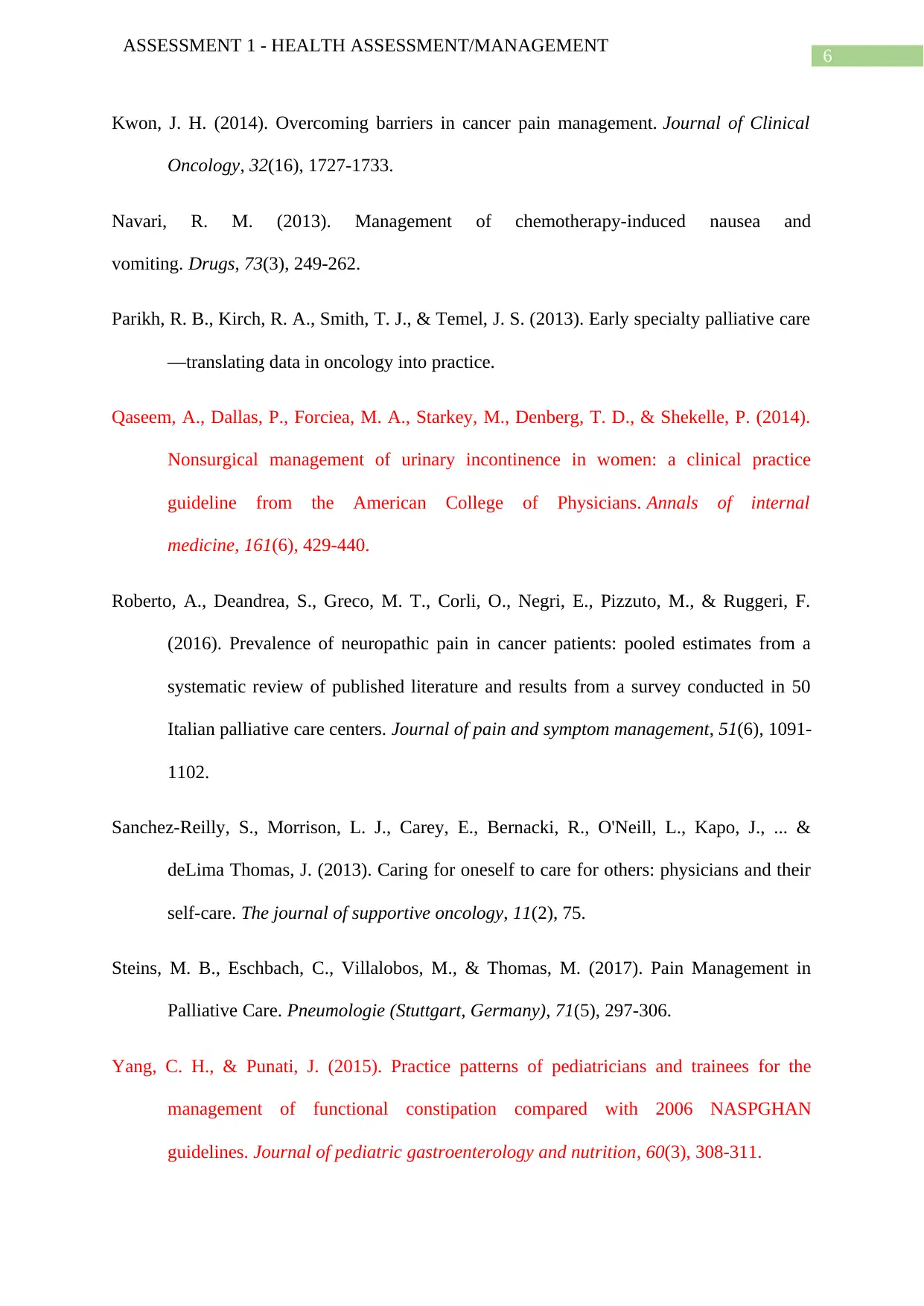
6
ASSESSMENT 1 - HEALTH ASSESSMENT/MANAGEMENT
Kwon, J. H. (2014). Overcoming barriers in cancer pain management. Journal of Clinical
Oncology, 32(16), 1727-1733.
Navari, R. M. (2013). Management of chemotherapy-induced nausea and
vomiting. Drugs, 73(3), 249-262.
Parikh, R. B., Kirch, R. A., Smith, T. J., & Temel, J. S. (2013). Early specialty palliative care
—translating data in oncology into practice.
Qaseem, A., Dallas, P., Forciea, M. A., Starkey, M., Denberg, T. D., & Shekelle, P. (2014).
Nonsurgical management of urinary incontinence in women: a clinical practice
guideline from the American College of Physicians. Annals of internal
medicine, 161(6), 429-440.
Roberto, A., Deandrea, S., Greco, M. T., Corli, O., Negri, E., Pizzuto, M., & Ruggeri, F.
(2016). Prevalence of neuropathic pain in cancer patients: pooled estimates from a
systematic review of published literature and results from a survey conducted in 50
Italian palliative care centers. Journal of pain and symptom management, 51(6), 1091-
1102.
Sanchez-Reilly, S., Morrison, L. J., Carey, E., Bernacki, R., O'Neill, L., Kapo, J., ... &
deLima Thomas, J. (2013). Caring for oneself to care for others: physicians and their
self-care. The journal of supportive oncology, 11(2), 75.
Steins, M. B., Eschbach, C., Villalobos, M., & Thomas, M. (2017). Pain Management in
Palliative Care. Pneumologie (Stuttgart, Germany), 71(5), 297-306.
Yang, C. H., & Punati, J. (2015). Practice patterns of pediatricians and trainees for the
management of functional constipation compared with 2006 NASPGHAN
guidelines. Journal of pediatric gastroenterology and nutrition, 60(3), 308-311.
ASSESSMENT 1 - HEALTH ASSESSMENT/MANAGEMENT
Kwon, J. H. (2014). Overcoming barriers in cancer pain management. Journal of Clinical
Oncology, 32(16), 1727-1733.
Navari, R. M. (2013). Management of chemotherapy-induced nausea and
vomiting. Drugs, 73(3), 249-262.
Parikh, R. B., Kirch, R. A., Smith, T. J., & Temel, J. S. (2013). Early specialty palliative care
—translating data in oncology into practice.
Qaseem, A., Dallas, P., Forciea, M. A., Starkey, M., Denberg, T. D., & Shekelle, P. (2014).
Nonsurgical management of urinary incontinence in women: a clinical practice
guideline from the American College of Physicians. Annals of internal
medicine, 161(6), 429-440.
Roberto, A., Deandrea, S., Greco, M. T., Corli, O., Negri, E., Pizzuto, M., & Ruggeri, F.
(2016). Prevalence of neuropathic pain in cancer patients: pooled estimates from a
systematic review of published literature and results from a survey conducted in 50
Italian palliative care centers. Journal of pain and symptom management, 51(6), 1091-
1102.
Sanchez-Reilly, S., Morrison, L. J., Carey, E., Bernacki, R., O'Neill, L., Kapo, J., ... &
deLima Thomas, J. (2013). Caring for oneself to care for others: physicians and their
self-care. The journal of supportive oncology, 11(2), 75.
Steins, M. B., Eschbach, C., Villalobos, M., & Thomas, M. (2017). Pain Management in
Palliative Care. Pneumologie (Stuttgart, Germany), 71(5), 297-306.
Yang, C. H., & Punati, J. (2015). Practice patterns of pediatricians and trainees for the
management of functional constipation compared with 2006 NASPGHAN
guidelines. Journal of pediatric gastroenterology and nutrition, 60(3), 308-311.
Paraphrase This Document
Need a fresh take? Get an instant paraphrase of this document with our AI Paraphraser

7
ASSESSMENT 1 - HEALTH ASSESSMENT/MANAGEMENT
ASSESSMENT 1 - HEALTH ASSESSMENT/MANAGEMENT
1 out of 8
Your All-in-One AI-Powered Toolkit for Academic Success.
+13062052269
info@desklib.com
Available 24*7 on WhatsApp / Email
![[object Object]](/_next/static/media/star-bottom.7253800d.svg)
Unlock your academic potential
© 2024 | Zucol Services PVT LTD | All rights reserved.





